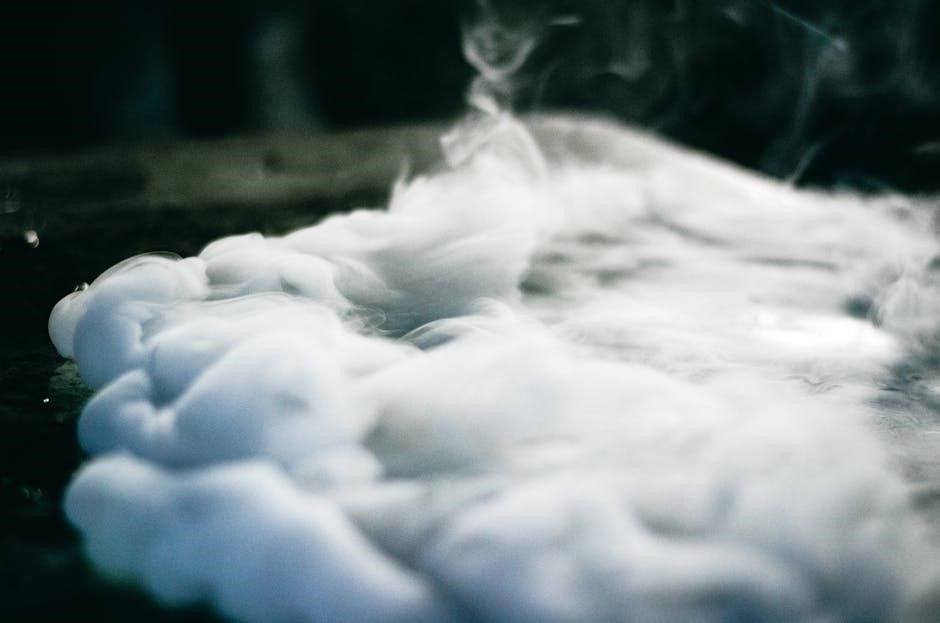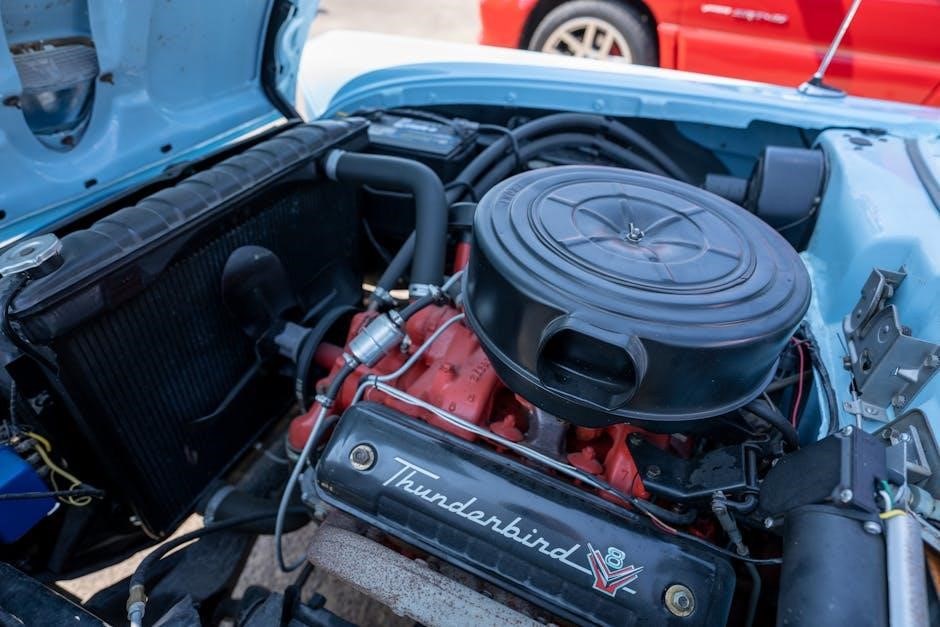Honeywell evaporative air coolers are portable, energy-efficient devices that use water evaporation to cool air, ideal for dry climates and indoor/outdoor use, offering eco-friendly cooling solutions.
1.1 Overview of Evaporative Cooling Technology
Eaporative cooling technology cools air naturally by drawing hot air through a wet honeycomb media, causing water evaporation and lowering air temperature. This eco-friendly method uses water to moisten cooling pads, creating a cooling effect without refrigerants. Ideal for dry climates, it enhances air quality by adding moisture, making it a cost-effective alternative to traditional air conditioning systems. The process is energy-efficient and environmentally friendly, providing a sustainable cooling solution for various indoor and outdoor spaces.
1.2 Benefits of Using Honeywell Evaporative Air Coolers
Honeywell evaporative air coolers offer energy-efficient cooling without refrigerants, lowering operating costs. They are portable, eco-friendly, and ideal for dry climates, providing natural cooling through water evaporation. These units also humidify the air, improving comfort in arid environments. With minimal maintenance and no harmful emissions, they are a sustainable alternative to traditional AC systems, perfect for indoor and outdoor use while promoting better air quality and cost savings.

Setting Up Your Honeywell Evaporative Air Cooler
Setting up your Honeywell evaporative air cooler involves unboxing, initial inspection, and proper placement. Ensure the unit is on a level surface and near a power source for optimal performance.
2.1 Unboxing and Initial Inspection
Start by carefully unboxing your Honeywell evaporative air cooler and inspecting for any damage. Check all components, including the remote control, casters, water tank, and cooling media. Ensure all parts are included and undamaged. Read the manual thoroughly before proceeding to understand the setup process. This step ensures a smooth and safe installation, helping you identify any potential issues early on. Proper inspection guarantees optimal performance and longevity of your cooler.
2.2 Placement and Installation Guidelines
Position the Honeywell evaporative air cooler near an open window to ensure proper airflow. Ensure cross-ventilation by opening another window or door opposite the cooler. Place it on a level, stable surface away from direct sunlight and heat sources. Keep a few feet away from walls and furniture to avoid airflow obstruction. Adjust the louvers to direct airflow where needed. Use a GFCI-protected outlet for electrical safety, especially near water. Place it on a waterproof surface to prevent damage from spills.
2.3 Filling the Water Tank and Preparing for Use
Before using your Honeywell evaporative air cooler, ensure the water tank is filled with fresh water. Turn off the cooler and unplug it for safety. Locate the water tank, usually at the bottom or back of the unit, and remove it. Fill the tank with cool water to the maximum level indicated to avoid overflow. Replace the tank securely and plug in the unit. Check the filter and ensure all parts are properly aligned. Refer to the manual for specific model instructions. Always test the cooler after setup to ensure proper function.

Operating the Honeywell Evaporative Air Cooler
Turn on the cooler, select your desired mode, and adjust fan speed using the control panel or remote. The unit will activate evaporative cooling once the honeycomb media is wet.
3.1 Understanding the Control Panel and Remote Control
The control panel features buttons for power, speed, and mode selection. The remote control offers convenience, allowing you to adjust settings from a distance. Key functions include switching between cooling and fan-only modes, adjusting fan speed (low, medium, high, or natural), and setting the timer for up to 7.5 hours. The panel also includes indicators for water levels and mode selection. Use the water regulator knob to control moisture output. Refer to the manual for detailed remote and panel functionality.

3.2 Adjusting Cooling Settings and Fan Speed
Adjust cooling settings and fan speed using the control panel or remote. Select from low, medium, or high fan speeds to customize airflow. For natural airflow, choose the natural mode. In cooling mode, the water pump activates, wetting the honeycomb media for evaporative cooling. Use the manual water regulator knob to adjust water flow for optimal cooling and humidity. Ensure the water tank is filled adequately for consistent performance. Regularly clean the carbon dust filter to maintain airflow efficiency and enhance cooling effectiveness.
3.3 Using the Timer Function for Energy Efficiency
The timer function allows you to program the cooler to operate for up to 7.5 hours, enhancing energy efficiency. Set the timer using the remote control or control panel. This feature ensures the unit turns off automatically, saving energy and reducing operating costs. Use the timer to cool your space only when needed, promoting efficient energy use without compromising comfort. Regular use of the timer helps maintain optimal performance while minimizing electricity consumption, making it an eco-friendly choice for cooling your environment.
3.4 Activating Evaporative Cooling Mode
To activate evaporative cooling mode, ensure the water tank is filled and the unit is turned on. Select the Cool mode using the remote control or control panel. The water pump will begin operating, saturating the honeycomb cooling media. Once the media is wet, cool, moist air will be released. If the water level is low, the sensor will trigger an alarm. This mode efficiently cools the air through water evaporation, providing a natural and energy-efficient cooling experience. Always ensure proper water levels for optimal performance.

Maintenance and Cleaning
Regular maintenance ensures optimal performance. Clean the carbon dust filter and honeycomb media, drain and refill the water tank, and follow a maintenance schedule for longevity.
4.1 Cleaning the Carbon Dust Filter
To maintain your Honeywell evaporative air cooler’s performance, regularly clean the carbon dust filter. Turn off the unit, unplug it, and locate the filter in the rear grill. Remove the filter and gently vacuum or rinse it with water. For stubborn dirt, use mild soap and rinse thoroughly. Allow the filter to dry completely before reinstalling. Cleaning the filter ensures better air quality and prevents dust buildup, keeping your cooler efficient and effective. Regular maintenance prolongs the filter’s lifespan and overall unit performance.
4.2 Maintaining the Honeycomb Cooling Media
The honeycomb cooling media is crucial for effective evaporative cooling. To maintain it, turn off the unit and unplug it. Gently remove the media and rinse with clean water to remove dirt or mineral buildup. Avoid using harsh chemicals or abrasive cleaners, as they may damage the material. Allow the media to dry completely before reinstalling. Regular cleaning ensures optimal water absorption and evaporation, maintaining cooling efficiency and preventing mold growth. Proper maintenance extends the lifespan of the honeycomb media and enhances overall cooler performance.
4.3 Draining and Refilling the Water Tank
Regularly drain and refill the water tank to ensure optimal performance and prevent mold growth. Turn off the unit and unplug it before draining. Locate the drain plug at the bottom of the tank and empty the water into a sink or bucket. Rinse the tank with clean water to remove any sediment. Refill the tank with fresh water, ensuring not to exceed the maximum water level indicated in the manual. Use distilled or tap water, avoiding additives to maintain efficiency and prevent clogging.
4.4 Regular Maintenance Schedule
Perform regular maintenance to ensure your Honeywell evaporative air cooler operates efficiently. Clean the carbon dust filter weekly and inspect the honeycomb cooling media for buildup. Drain and refill the water tank every 1-2 weeks to prevent mold and bacteria growth. Monthly, check and clean the water pump and ensure proper water flow. Seasonally, dry the cooling media and store the unit in a dry place during off-seasons. Regular upkeep ensures optimal performance and extends the cooler’s lifespan.

Troubleshooting Common Issues
Address common issues like low airflow, water leaks, or strange noises by checking filters, water levels, and connections. Refer to the manual for detailed solutions.
5.1 Low Airflow or Weak Cooling Performance
Low airflow or weak cooling performance can result from a blocked carbon dust filter, insufficient water levels, or improper placement. Ensure the filter is clean and the water tank is filled adequately. Check if the cooler is placed near an open window for proper cross-ventilation. If issues persist, inspect the honeycomb media for damage or blockages and ensure the unit is suited for your room size and humidity levels. Regular maintenance can help restore optimal performance.
5.2 Water Leaks or Excess Moisture
Water leaks or excess moisture may occur due to overfilling the tank, improper drain plug installation, or high humidity levels. Ensure the water tank is not overfilled and the drain plug is securely closed. Check for blockages in the water distribution system and verify that the cooler is placed on a level surface. Excess moisture can also indicate poor ventilation, so ensure proper airflow in the room. Regularly cleaning the unit and monitoring water levels can help prevent these issues.
5.3 Strange Noises or Vibrations
Strange noises or vibrations may occur due to an unbalanced unit, debris in the fan, or issues with the motor. Ensure the cooler is placed on a level surface and check for obstructions in the fan or grills. If noises persist, inspect the motor or belts for wear. Turn off the unit and unplug it before performing any maintenance. Regular cleaning and ensuring proper assembly can help minimize vibrations and unusual sounds, ensuring smooth operation and longevity of the device.
5.4 Low Water Sensor and Alarm
If the low water sensor is triggered, the unit will emit a beeping sound, and the “TANK EMPTY” indicator will flash. This occurs when water levels in the tank drop below the minimum required for cooling mode. To resolve this, refill the water tank to the recommended level. Ensure the sensor is clean and functioning properly. If the issue persists, check for blockages in the water supply system. Always operate the cooler with adequate water to avoid damage to the pump and maintain optimal performance and longevity of the device.

Safety Precautions and Guidelines
Always prioritize safety by using GFCI-protected outlets, ensuring proper ventilation, and avoiding outdoor use during heavy rain or snow to prevent electrical hazards and ensure efficiency.
6.1 Electrical Safety Tips
Ensure the unit is plugged into a GFCI-protected outlet to prevent electrical hazards. Always match the household voltage to the product specifications. Avoid using the cooler near water sources or in wet conditions. Keep the power cord away from water and heat sources. Never operate the unit with a damaged cord or plug. Unplug the cooler before cleaning or maintaining it. Avoid overloading circuits and use the cooler on a stable, flat surface. Always follow the manufacturer’s electrical guidelines for safe operation.
6.2 Proper Ventilation Requirements
Ensure proper ventilation by placing the cooler near an open window or door to allow fresh air to circulate. Cross-ventilation is essential for optimal performance. Position the unit so that outside air enters the cooler, circulates in the room, and exits through another opening. Avoid obstructing the airflow around the unit. Keep doors and windows open to maintain airflow efficiency and prevent moisture buildup. Proper ventilation ensures effective cooling and prevents excessive humidity in the room.
6.3 Usage in Diverse Climates and Environments
Honeywell evaporative air coolers are designed for use in various climates, primarily excelling in dry, low-humidity environments. They are ideal for indoor and outdoor settings, including patios and decks. Outdoor models are built to withstand light rain and dust, with IPX4 ratings for weather resistance. Ensure the unit is placed on a level surface and protected from direct sunlight to maximize efficiency. Regularly check and maintain water levels for consistent performance in different climates and conditions.

User Tips for Optimal Performance
Position the cooler near an open window for cross-ventilation, ensuring maximum airflow. Use in low-humidity environments for best results. Adjust water regulator for efficient cooling and humidity control.
7.1 Positioning the Cooler for Maximum Efficiency
For optimal performance, place the Honeywell evaporative air cooler near an open window or door to ensure proper airflow. Position it in a way that allows outside air to enter and circulate freely. Cross-ventilation enhances cooling efficiency, as the unit draws in hot air, cools it, and releases it back. Ensure the cooler is not obstructed by furniture or walls, and maintain a slight incline if possible. Ideal placement maximizes the cooling effect and ensures efficient operation in dry climates.
7.2 Managing Humidity Levels for Better Cooling
Evaporative coolers thrive in dry climates, as they add moisture to the air through evaporation. For optimal performance, ensure humidity levels are moderate. Use a hygrometer to monitor indoor humidity. Ideal levels range between 30-50%. If humidity is too high, the cooling effect may diminish. Adjust the water regulator knob to control moisture output. Lower humidity allows the unit to cool more effectively. Regularly monitor and balance humidity for enhanced comfort and energy efficiency, ensuring the cooler operates at its best capacity.
7;3 Energy-Saving Practices
To maximize energy efficiency, use the timer function to run the cooler only when needed. Adjust the water regulator to avoid over-humidification, as this reduces cooling efficiency. Lower fan speeds when cooling is sufficient. Ensure proper ventilation to enhance airflow, reducing the need for higher settings. Regularly clean filters and maintain the unit to optimize performance. These practices not only lower energy consumption but also extend the cooler’s lifespan, making it a cost-effective and eco-friendly cooling solution for your space.

Understanding the Manual and Warranty
The manual provides essential guidance for operating and maintaining your Honeywell evaporative air cooler, while the warranty ensures protection and support for repairs and replacements within specified terms.
8.1 Navigating the User Manual
The user manual is a comprehensive guide designed to help you understand and optimize your Honeywell evaporative air cooler’s performance. It includes detailed sections on setup, operation, maintenance, and troubleshooting. Start with the quick start guide for initial setup, then explore features like cooling modes, water tank management, and timer functions. Safety precautions and warranty information are also highlighted to ensure safe and efficient use. Refer to the manual regularly for tips on maximizing your cooler’s efficiency and addressing common issues promptly.
8.2 Warranty Terms and Conditions
Honeywell evaporative air coolers come with a warranty that covers manufacturing defects in materials and workmanship. The standard warranty period typically lasts for one year from the date of purchase, but this may vary depending on the model and region. The warranty is void if the product is misused, tampered with, or not maintained properly. Registering your product can enhance warranty benefits. Always refer to the manual for specific terms and conditions, as they may differ by model and region. Proper use and maintenance are essential to ensure warranty coverage.
8.3 Contacting Honeywell Customer Support
For assistance with your Honeywell evaporative air cooler, contact customer support via phone, email, or through the official website. Visit the Honeywell website for regional contact details and support options. Ensure you have your model number and purchase details ready for efficient service. Honeywell also provides online resources, including user manuals and troubleshooting guides, to help resolve common issues. Their dedicated team is available to address queries and concerns, ensuring optimal performance of your evaporative air cooler.

Comparing Honeywell Models
Honeywell offers various evaporative air cooler models, differing in water tank size, CFM ratings, and features like remote control, portability, and evaporative cooling efficiency for diverse needs.
9.1 Key Features of Different Models
Honeywell evaporative air coolers vary in features such as CFM ratings, water tank capacity, and additional functions. The CL30XC model offers high airflow and large water tanks, while the CS10PE is compact and lightweight. The CO25AE includes remote control and timer functions for convenience. Some models feature advanced honeycomb cooling media for improved efficiency, while others include ice compartments for enhanced cooling. Each model is designed to suit different room sizes and user preferences, ensuring optimal performance in various settings.
9.2 Choosing the Right Model for Your Needs
Selecting the ideal Honeywell evaporative air cooler involves considering room size, desired cooling capacity, and specific features. Assess your space and climate to determine the appropriate CFM rating. If portability is key, opt for compact models like the CS10PE. For larger areas, the CL30XC offers higher airflow. Features like remote control, timers, and ice compartments should align with your lifestyle. Match your needs with the model’s capabilities to ensure efficient cooling and satisfaction, while also considering ENERGY STAR certification for energy efficiency. This helps optimize performance and cost savings.
Honeywell evaporative air coolers offer an efficient, eco-friendly alternative to traditional air conditioning. By following the manual’s guidelines, users can maximize performance and enjoy cool, moist air. Proper setup, maintenance, and troubleshooting ensure longevity. These units are ideal for dry climates and provide cost-effective comfort. With various models available, selecting the right one for your space ensures optimal cooling. Honeywell’s commitment to quality and energy efficiency makes their evaporative coolers a reliable choice for home and outdoor use, enhancing comfort naturally and sustainably.
